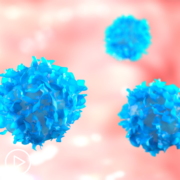Myeloma Expert Gives an Overview of Novel Therapies from Patient Empowerment Network on Vimeo.
What novel multiple myeloma therapies are available for patients? Dr. Sikander Ailawadhi from the Mayo Clinic shares an overview of novel therapies of CAR T-cell therapy, monoclonal antibodies, bispecifics, and immunomodulators and discusses therapies currently in rapid development.
Download Guide
Descargar Guía
See More from START HERE Myeloma
Related Programs:
Transcript:
Lisa Hatfield:
We are going to jump right into a discussion about some of the novel therapies that there is much buzz about right now, and it’s kind of an alphabet soup these novel therapies. I actually was trying to digest all of this information and divide it into the general categories.
And correct me if I’m wrong, but we have monoclonal antibodies, we have bispecific antibodies like the CAR-T therapies, and they target different things. We have BCMA, we have GPRC5D, FcRH5, we have things called antibody drug conjugates and cell mods. So, Dr. Ailawadhi, if you can just give us kind of a broad overview of these therapies and how they may be used to harness our immune system, and how they come into play when you’re treating your patients, how and when they come into play when treating your patients.
Dr. Sikander Ailawadhi:
Surely, so I think thanks a lot for bringing up that discussion, this is extremely important, and I think it’s most important because if a myeloma patient goes online and wants to search for information or research, these things start coming up this term start coming up. So it’s extremely important for a knowledgeable and empowered patient to learn about these, understand them, so that they are able to digest that information. And I should mention that a lot of what we’ll talk about about these particular treatments may not be applicable to newly diagnosed patients or a recently diagnosed patient, but this is important enough and exciting enough that I would want every single patient to pick up this information. Learn it hopefully, and maybe park it for now somewhere, so that hopefully down the road it becomes important and handy.
So you asked about monoclonals, bispecific, CAR-Ts, cell mols, etcetera. Let’s take a step back, let’s think about these as strategies to target myeloma. Myeloma treatment is going through a change where immunotherapy and harnessing the body’s own immune system is becoming extremely important, and when we do that, the immunotherapy is typically very targeted, so what these drugs these agents, these terms, this alphabet soup is doing is it is targeting specific markers on the myeloma cell on the plasma cell.
For example, one of the markers is CD38. There is a monoclonal antibody. There are actually two monoclonal antibodies. Daratumumab (Darzalex), rituximab (Rituxan) that are FDA-approved, but there are other ways of targeting CD38, for example, CD38 targeting CAR-T cells, CD38 targeting antibody drug conjugates, etcetera. So CD38 is one important part. A very, very, very important thing in the past one year or a year-and-a-half has been what’s called B-C-M-A, B cell maturation antigen. BCMA is another target on plasma cells. Very effective, very specific.
So there are many, many drugs that are available and becoming available to target BCMA. Right now, there are three drugs that are FDA-approved that can target BCMA. Two of them are CAR-T cells, a particular way of going after BCMA in which the body’s own T cells are collected. These are not stem cells, these are T cells, T lymphocytes, these T cells are collected, they are actually genetically modified to go and fight against the BCMA, and then those modified T cells are multiplied in the lab and given to the person as a drug, they go and seek the plasma cells because of BCMA kill them harnessing the body’s immune system.
So there are two CAR-T cells against BCMA, one called ide-cel (Abecma) and one called cilta-cel (Avekti). There has recently been available a bispecific antibody against BCMA, we call it bispecific because it connects to BCMA from one end and from a second it connects to the body’s T cells again, bring the T cells close to the plasma cells to kill them. Then bispecific antibodies called teclistamab (Tecvayli). And until recently there was another drug available against BCMA which was what’s called an antibody drug conjugate. This drug is called belantamab (Blenrep) for the timing, belantamab has been removed or withdrawn from the market in the U.S., but there are ongoing clinical trials and down the road, it may come back again.
Now, antibody drug conjugate is another way of targeting something in which there is a seeker for the BCMA in this case, and it has a payload of some kind of a toxin, so that when the drug connects to the plasma cell through the BCMA in this case, that toxin is released, it can kill the cell, so either we harness the body’s immune cells, the T cells by CAR-T or bispecific, or we kill the cell by releasing a toxic payload from a drug, antibody drug conjugate, these are all different methods of targeting the myeloma cell. So I talked to you about monoclonal bispecific CAR-T and ADC as different strategies, CD38 and BCMA, some of these strategies are available, but there are other targets which are very exciting and new drugs are being developed against them, two of the very interesting targets there one is called GPRC5D, and the other is FcRH5.
These GPR5CD or FcRH5 are two different targets on myeloma cells. No drugs are currently FDA-approved, but they are being developed very rapidly, and we have a couple of extremely promising agents which will be coming down the pipe. And you also mentioned something called cell mods. Cell mods are some newer drugs in the family of what’s called IMiDs or immunomodulators, in which our patients may be aware of thalidomide (Thalomid), lenalidomide (Revlimid), and pomalidomide (Pomalyst). The cell mods are kind of the same family, and there are a couple of them that are also being developed.
So why is this important for everybody, whether they are newly diagnosed or relapsed or long-term survivor with myeloma, because this tells you that not only are we getting newer drugs in the same classes, we are also getting brand new classes of drugs, and you can imagine that means that those brand new strategies are ways to target the plasma cell, we know cancer cells are smart and they develop invasive mechanisms to become resistant to drugs, but every time something gets resistant if we have a brand new mechanism to go against the disease, but that’s exciting because that’s why we are seeing deeper responses, even in very heavily pre-treated patients, because we are using newer specific, relatively safe, convenient strategies to going after the plasma cell.
I know that was a lot of information, but I hope this helps our listeners learn a little bit about what you rightly said is an alphabet soup, but I would like us to think about it as an exciting time for being a myeloma doctor, and certainly a very hopeful situation for all our patients.









